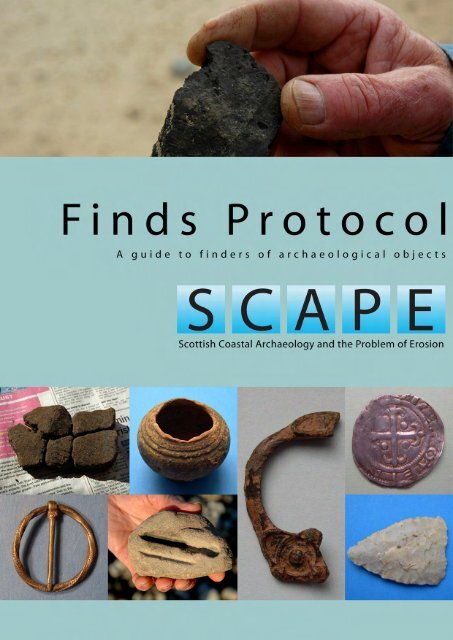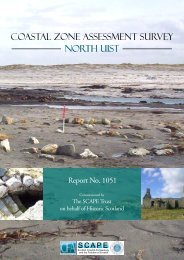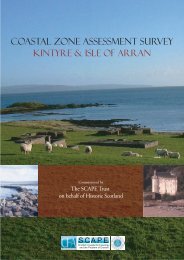Click here to download the file - SCAPE
Click here to download the file - SCAPE
Click here to download the file - SCAPE
Create successful ePaper yourself
Turn your PDF publications into a flip-book with our unique Google optimized e-Paper software.
Finding archaeological objects: a quick guide <strong>to</strong> best practiceWhen you have discovered an archaeological object t<strong>here</strong> are a number of things thatyou can do, and one that you must do. This is summarized below and explained in moredetail later in <strong>the</strong> text.The things that you CAN do include:• picking up <strong>the</strong> object and s<strong>to</strong>ring it temporarily it in a safe and suitableenvironment.• recording <strong>the</strong> location of <strong>the</strong> object.• taking pho<strong>to</strong>graphs of <strong>the</strong> object and <strong>the</strong> place w<strong>here</strong> you found it.What you MUST do is: report your discovery <strong>to</strong> <strong>the</strong> Scottish Archaeological Finds Allocation Panel(SAFAP)or contact your Local Authority archaeologist or Museums Officer who can help youidentify your find. They will <strong>the</strong>n report <strong>the</strong> find <strong>to</strong> SAFAP on your behalf. Yourname will put down as <strong>the</strong> finder of <strong>the</strong> object, and any rewards due will be paid<strong>to</strong> you.<strong>SCAPE</strong> encourages everyone <strong>to</strong> follow <strong>the</strong> guidelines in this pamphlet,and in that way ad<strong>here</strong> <strong>to</strong> what is considered <strong>to</strong> be best practice.1
When <strong>to</strong> collect….Two basic premises should be kept in mind when picking up stray archaeological findsfrom <strong>the</strong> ground. One is <strong>the</strong> notion that archaeological objects and sites areprecious, fragile and finite resources which need <strong>to</strong> be treated with care andattention. The o<strong>the</strong>r is that in order for new archaeological discoveries <strong>to</strong> be recorded ina meaningful way it is necessary <strong>to</strong> know exactly w<strong>here</strong> an object was found.If an object is lying on <strong>the</strong> ground surface, be it in a field, on <strong>the</strong> beach or in your garden,you may pick it up. Remember that you should take note of w<strong>here</strong> <strong>the</strong> object wasfound. If you do decide <strong>to</strong> pick up an archaeological object and take it home you shouldmake sure that it is s<strong>to</strong>red in a manner that will not damage it. While <strong>the</strong> find is in yourcare (whe<strong>the</strong>r in your home or in your coat pocket) it is your responsibility <strong>to</strong> s<strong>to</strong>re itsafely.…and when not <strong>to</strong> collect!As a general rule, if an object is embedded in soil (for instance, an exposed section ordune face or an archaeological feature on <strong>the</strong> ground) do NOT attempt <strong>to</strong> pull it out. Thiswill speed up <strong>the</strong> erosion of archaeological deposits, and you may damage <strong>the</strong> object in<strong>the</strong> process. What you can do instead is <strong>to</strong> record <strong>the</strong> location of your discovery andreport it <strong>to</strong> your Local Authority Archaeologist.If an object is fragmented and <strong>the</strong> pieces are found <strong>to</strong>ge<strong>the</strong>r in <strong>the</strong> same spot (forinstance a broken bone object or two halves of <strong>the</strong> same s<strong>to</strong>ne <strong>to</strong>ol), it can be a goodidea <strong>to</strong> pick up all <strong>the</strong> pieces. However, a scatter of archaeological objects, like flints ormidden material, can be an indica<strong>to</strong>r of an archaeological site. In this case <strong>the</strong> objectsshould not be picked up. Your Local Authority Archaeologist should be informed of <strong>the</strong>discovery, or you can contact <strong>SCAPE</strong>.2
It is very common <strong>to</strong> find small bits of pottery and midden material, such as animal boneand shells, near <strong>to</strong> eroding archaeological sites, particularly on sandy beaches. Beforepicking this type of material up you should consider what will happen <strong>to</strong> it once you haveremoved it from <strong>the</strong> site and taken it home. Are you going <strong>to</strong> report your discovery <strong>to</strong> anarchaeologist? Are you going <strong>to</strong> take <strong>the</strong> finds <strong>to</strong> your local museum? Will <strong>the</strong> objectsend up on your mantle piece? Or in <strong>the</strong> pocket of your waterproof jacket? While youhave a legal obligation <strong>to</strong> report all archaeological discoveries, it is not always practical<strong>to</strong> do so for every single bit of pottery that you find. Instead, leave <strong>the</strong> objects w<strong>here</strong> youfound <strong>the</strong>m, make a note of <strong>the</strong> location and tell your Local Authority Archaeologistabout it.Scheduled Ancient MonumentsSome archaeological sites and monuments are classified as ScheduledAncient Monuments. Such sites are protected by law. To remove anarchaeological find discovered within a scheduled area (including metaldetecting) is a criminal offence.T<strong>here</strong> are about 8000 scheduled sites across Scotland. To find out if aspecific archaeological site is scheduled, and <strong>the</strong> extent of <strong>the</strong> protectedarea, please contact His<strong>to</strong>ric Scotland (details on p. 9).What <strong>to</strong> do with your findWhen you discover an archaeological object and pick it up, <strong>the</strong> most important bit ofinformation <strong>to</strong> remember is <strong>the</strong> location w<strong>here</strong> you found it. Having this information <strong>to</strong>hand helps pin point a find spot, should you, or someone else, need <strong>to</strong> return <strong>to</strong> it in <strong>the</strong>future. It also helps archaeologists keep track of w<strong>here</strong> objects are found, and w<strong>here</strong>new archaeological sites may be located.3
Record it!Recording a find spot is best done by relating <strong>the</strong> location <strong>to</strong> <strong>the</strong> British National Grid, forexample by recording <strong>the</strong> National Grid Reference with a handheld Global PositioningSystem device (GPS) or by plotting <strong>the</strong> site on<strong>to</strong> an Ordnance Survey map. If you donot have a map or a GPS with you make sure that you note down <strong>the</strong> find location assoon as you come home, while this is still fresh in your mind. Or even better, pho<strong>to</strong>graph<strong>the</strong> object in situ (i.e. w<strong>here</strong> you found it and before picking it up). Include as much of<strong>the</strong> surrounding landscape in your pho<strong>to</strong> as you can – this helps <strong>to</strong> show <strong>the</strong> location.For more information on how <strong>to</strong> record a National Grid Reference pleaserefer <strong>to</strong> <strong>the</strong> Shorewatch training manual which can be <strong>download</strong>ed from<strong>the</strong> Shorewatch website (http://www.shorewatch.co.uk)Label it!If you s<strong>to</strong>re a find in your home you should ensure that it is labelled properly <strong>to</strong> avoidconfusion, and <strong>to</strong> aid future identification. As a minimum, <strong>the</strong> information you shouldinclude is:The National Grid ReferenceThe date of when <strong>the</strong> object was discoveredYou can write <strong>the</strong>se details directly on<strong>to</strong> <strong>the</strong> plastic bag or container using an permanentmarker pen.Report it!Reporting your find is not only a legal requirement, it could mean that rare or valuableobjects will get <strong>the</strong> conservation treatment that <strong>the</strong>y need.4
Finding Human RemainsIt is not unusual <strong>to</strong> find human bones eroding out of sand dunes and on beaches. Whileit can sometimes be difficult <strong>to</strong> tell some human skeletal parts apart from animal bones itis important <strong>to</strong> report your discovery, if you think you may have found human remains.This is a legal requirement, in order <strong>to</strong> establish whe<strong>the</strong>r <strong>the</strong> human remains arearchaeological, or in fact part of a modern crime scene.It is far more likely that <strong>the</strong> remains you find belong <strong>to</strong> a dead animal, ra<strong>the</strong>r than ahuman. The most obvious human bones are <strong>the</strong> skull, <strong>the</strong> long bones and <strong>the</strong> pelvis.Figure 1 shows <strong>the</strong> bones of <strong>the</strong> human body. Compare what you have found <strong>to</strong> <strong>the</strong>diagram. To get an idea of how large <strong>the</strong> long bones of a human are, think of <strong>the</strong> size ofyour own bones. In general, a sheep has much shorter long bones, and a cow muchthicker ones. Because you shouldn’t disturb a human burial, a pho<strong>to</strong>graph can again bevery helpful.If you think you have found a humanskele<strong>to</strong>n, <strong>the</strong> first thing <strong>to</strong> do is <strong>to</strong> contactyour local police station who will visit <strong>the</strong>site and make a report. It is important thatyou leave <strong>the</strong> bones w<strong>here</strong> you found<strong>the</strong>m and that you do not disturb <strong>the</strong> site.Once you have contacted your local policestation you do not need <strong>to</strong> do anythingelse. If <strong>the</strong> Police take no fur<strong>the</strong>r action <strong>the</strong>case passes His<strong>to</strong>ric Scotland, who maysend a team of archaeologists <strong>to</strong> examine<strong>the</strong> site.Figure 1: A human skele<strong>to</strong>n.Source: www.learning-connections.co.uk5
How <strong>to</strong> s<strong>to</strong>re an archaeological objectThis section is about how <strong>to</strong> keep an archaeological find safe and prevent damage <strong>to</strong> it.Different objects require different environmental conditions depending on what <strong>the</strong>y aremade of. Below are some basic rules of thumb which you can follow while temporarilys<strong>to</strong>ring an archaeological find in your house.S<strong>to</strong>neObjects made of s<strong>to</strong>ne, such as flint and sands<strong>to</strong>ne, are normally quite resilient anddurable. However, <strong>the</strong>y can be more fragile than you think and should be handled withcare. Let wet s<strong>to</strong>ne objects dry slowly indoors on a wooden or plastic surface – neverdry <strong>the</strong>m in direct sunlight or close <strong>to</strong> a heater.Shale and jet: Dry shale and jet are very fragile and should be lifted or handled verycarefully. Wet shale and jet should be s<strong>to</strong>red wet or humid. Do not re-wet shale and jetwhich has dried out, as it may shatter.Amber: S<strong>to</strong>re waterlogged amber wet. Dry amber should be s<strong>to</strong>red humid.PotteryPottery is made of dried, fired clay and is very fragile. Prehis<strong>to</strong>ric pottery, in particular, isextremely fragile, especially when wet. Do NOT attempt <strong>to</strong> clean it by rubbing it withyour fingers or washing it, as any applied decoration will come off or <strong>the</strong> whole sherdmay crumble. Sherds can be dried on a newspaper lined tray; this should happenslowly, and never in direct sunlight or close <strong>to</strong> a heater. Once dry, pottery sherds maybe s<strong>to</strong>red in small plastic bags or lidded plastic containers. To avoid abrasion do nots<strong>to</strong>re <strong>to</strong>o many sherds <strong>to</strong>ge<strong>the</strong>r in <strong>the</strong> same container.6
IronKeep all waterlogged iron objects wet – do not allow <strong>the</strong>m <strong>to</strong> dry out. Dry iron objectscan be s<strong>to</strong>red on newspaper lined trays or in plastic bags/containers, but make sure <strong>to</strong>perforate plastic containers <strong>to</strong> allow airing.Non-ferrous metalsNon-ferrous metals include copper, copper-alloys, bronze, tin, lead, silver and gold. Allobjects of <strong>the</strong>se materials should be allowed <strong>to</strong> dry and s<strong>to</strong>red in a dry environment.Once dry, <strong>the</strong>y should be handled as little as possible.You may be lucky enough <strong>to</strong> find a coin. If so, avoid <strong>the</strong> temptation of rubbing orcleaning <strong>the</strong> faces <strong>to</strong> see if it has a date. Coins can be very fragile and important detailscan be damaged if you clean <strong>the</strong> surfaces.Organic objectsOrganic materials include wood, lea<strong>the</strong>r, textile, bone, antler, ivory and horn. Objectsmade of any of <strong>the</strong>se materials need <strong>to</strong> be kept in a moist environment. Do not let <strong>the</strong>mdry out as <strong>the</strong>y will crack and split! Seal organic objects in a plastic bag or lidded plasticcontainer and keep <strong>the</strong>m cool (for instance in <strong>the</strong> fridge). If you have several organicobjects of different materials s<strong>to</strong>re <strong>the</strong>m in separate plastic bags, sorted by material.Making archaeological discoveries: <strong>the</strong> legal situationTreasure TroveIn Scotland, ALL lost and abandoned property which is not o<strong>the</strong>rwise owned belongs <strong>to</strong><strong>the</strong> Crown. This is defined by <strong>the</strong> regalia minora common law rights of <strong>the</strong> Crown inScotland. Thus, all objects whose original owner or rightful heir cannot be identified ortraced are <strong>the</strong> property of <strong>the</strong> Crown, and this also applies <strong>to</strong> objects of archaeologicaland his<strong>to</strong>rical interest. This system is known as Treasure Trove.7
It does not matter whe<strong>the</strong>r objects were lost or intentionally hidden, or what material<strong>the</strong>y are made of – <strong>the</strong> Crown may claim finds of almost any date, made from any typeof material. Generally, finds such as fragments of farm machinery, 19th and 20thcentury coins and o<strong>the</strong>r modern, everyday objects need not be reported. The systemapplies <strong>to</strong> finds from anyw<strong>here</strong> in Scotland, on land, from inland waters, from withinharbours, and from <strong>the</strong> coast and estuaries down <strong>to</strong> mean low water level.Receiver of WreckThe duty <strong>to</strong> declare finds also extends <strong>to</strong> <strong>the</strong> sea and seabed – in this case reporting is<strong>to</strong> <strong>the</strong> Receiver of Wreck. The Receiver of Wreck deals with wreck which comes fromtidal waters up <strong>to</strong> mean low water level. All wreck material raised from <strong>the</strong> seabed mustbe reported and this includes archaeological material. This could be a medieval pot, goldcoins, a prehis<strong>to</strong>ric spearhead or a canon. As with Treasure Trove, a finder reporting afind <strong>to</strong> <strong>the</strong> Receiver of Wreck may be entitled <strong>to</strong> a reward, called salvage award.Reporting your findIn cases of Treasure Trove <strong>the</strong> Crown Agent is advised by a panel of experts, appointedby <strong>the</strong> Scottish Ministers, <strong>the</strong> National Museums of Scotland and <strong>the</strong> Scottish MuseumsCouncil. This panel is known as <strong>the</strong> Scottish Archaeological Finds Allocation Panel(SAFAP) and this is <strong>the</strong> body <strong>to</strong> which you report when you have discovered anarchaeological object. Details of how <strong>to</strong> report a discovery can be found on <strong>the</strong> TreasureTrove website (http://www.treasuretrovescotland.co.uk). Most often this processhappens via your local museum cura<strong>to</strong>r or Local Authority archaeologist.Once an object has been submitted it will be assessed on behalf of <strong>the</strong> SAFAP as <strong>to</strong>whe<strong>the</strong>r <strong>the</strong> object should be claimed as Treasure Trove or not. If it is claimed <strong>the</strong>SAFAP will recommend which museum <strong>the</strong> object should be allocated <strong>to</strong>, and how much8
eward <strong>the</strong> finder should receive. If an object is not claimed it is returned <strong>to</strong> <strong>the</strong> finder forhim or her <strong>to</strong> keep or dispose of as <strong>the</strong>y please. For fur<strong>the</strong>r information on this processplease refer <strong>to</strong> <strong>the</strong> Treasure Trove website.References:Information on <strong>the</strong> treatment and s<strong>to</strong>rage of objects was summarised from Watkinson,N. and Neal V. 1972: First Aid for Finds. London.Information on <strong>the</strong> Treasure Trove system in Scotland was summarised from <strong>the</strong>Treasure Trove website: http://www.treasuretrovescotland.co.ukFur<strong>the</strong>r reading…Richard Hobbs, Celia Honeycombe and Sarah Watkins, 2002, ‘Guide <strong>to</strong> Conservationfor Metal Detec<strong>to</strong>rists’, Tempus. ISBN 0-7524-2522-6‘The Portable Antiquities Scheme’ website - http://www.finds.org.uk. The PortableAntiquities Scheme (PAS) is a voluntary scheme <strong>to</strong> record archaeological objects foundby members of <strong>the</strong> public. Although <strong>the</strong> scheme covers England and Wales only (notScotland) plenty of useful advise can be found on <strong>the</strong>ir website. Note that <strong>the</strong> Treasuresystem works differently in England, Wales and Nor<strong>the</strong>rn Ireland, than it does inScotland. The PAS website can provide more information on this.9
ContactsThe <strong>SCAPE</strong> TrustUniversity of St AndrewsSt. Katharine's Lodge, The ScoresSt. Andrews, FifeKY16 9ALTel: +44 (0) 1334 467172Fax: +44 (0) 1334 463025Email: helpdesk@scapetrust.orgWebsites: http://www.scapetrust.org and http://www.shorewatch.co.ukTreasure Trove SecretariatNational Museums of ScotlandChambers StreetEdinburghEH1 1JFEmail: info@treasuretrovescotland.co.ukWebsite: http://www.treasuretrovescotland.co.ukReceiver of WreckSpring Place105 Commercial RoadSouthamp<strong>to</strong>nSO15 1EGTel: +44 (0) 2380 329 474Email: row@mcga.gov.ukWebsite: http://www.mcga.gov.ukHis<strong>to</strong>ric ScotlandLongmore HouseSalisbury PlaceEdinburghEH9 1SHTel: +44 (0) 131 668 8600Website: http://www.his<strong>to</strong>ric-scotland.gov.uk10
Local Authority ArchaeologistsJudith S<strong>to</strong>nesKeeper of ArchaeologyAberdeen City CouncilWhitespace60 Frederick StreetABERDEEN AB24 5HYTel: 01224 523658Fax: 01224 523660e-mail: judiths@arts-rec.aberdeen.net.ukAberdeenshire; Angus; MorayIan ShepherdArchaeologist, Planning & DevelopmentAberdeenshire Council, Woodhill HouseWestburn RoadABERDEEN AB16 5GBTel: 01224 664723Fax: 01224 664713e-mail: ishepherd.ped@aberdeenshire.gov.ukhttp://www.aberdeenshire.gov.uk/web/archaeology.nsfArgyll and Bute; Glasgow City; E Ayrshire; ERenfrewshire; Inverclyde; N Ayrshire; NLanarkshire; Renfrewshire; S Ayrshire; SLanarkshire; W Dunbar<strong>to</strong>nshireDr Carol SwansonWest of Scotland Archaeology ServiceCharing Cross Complex, 20 India StreetGLASGOW G2 4PFTel: 0141 287 8332-3Fax: 0141 287 9259e-mail: carol.swanson@wosas.glasgow.gov.ukhttp://www.wosas.org.ukClackmannanshire; StirlingLorna MainArchaeologistEnvironmental ServicesStirling CouncilViewforthSTIRLING FK8 2ETTel: 01786 442752Fax: 01786 443003e-mail: mainl@stirling.gov.ukDumfries and GallowayJane BrannArchaeologist, Environment and InfrastructurePlanning and Environment GroupDumfries and Galloway CouncilNewall TerraceDUMFRIES DG1 1LWTel: 01387 260154Fax: 01387 260149e-mail: janeb@dumgal.gov.ukEast LothianBiddy SimpsonHeritage OfficerEast Lothian CouncilJohn Muir HouseHADDINGTON EH41 3HATel: 01620 827158Fax: 01620 827456e-mail: bsimpson1@eastlothian.gov.ukhttp://www.eastlothian.gov.uk/museums/archaeo11
City of EdinburghJohn LawsonArchaeology Officer, Archaeology ServiceDepartment of RecreationCity of Edinburgh Council10 Brough<strong>to</strong>n MarketEDINBURGH EH3 6NUTel: 0131 558 1040Fax: 0131 558 1090e-mail: john.lawson@edinburgh.gov.ukFalkirkGeoff BaileyKeeper of Archaeology & Local His<strong>to</strong>ryFalkirk CouncilCallendar HouseCallendar ParkFALKIRK FK1 1YRTel: 01324 503783Fax: 01324 503771e-mail: gbailey@falkirkmuseums.demon.co.ukFifeDouglas SpeirsArchaeologist, Planning and Building ControlService, Fife CouncilForth House, Abbotshall Road , KirkcaldyKY1 1RUTel: 01592 417912Fax: 01592 417641e-mail: fifearch@sol.co.ukHighlandArchaeology ServicePlanning & DevelopmentHighland CouncilGlenurquhart RoadINVERNESS IV3 5NXTel: 01463 702502Fax: 01463 702298http://www.higharch.demon.co.ukOrkneyJulie GibsonOrkney Archaeologistc/o Orkney CollegeWeyland, KirkwallORKNEY KW15 1LXTel: 01856 569341Fax: as abovee-mail: oat@lineone.netPerth and KinrossDavid StrachanArea ArchaeologistPerth & Kinross Heritage TrustThe Lodge4 York PlacePERTH PH2 8EPTel: 01738 477080e-mail: DLStrachan@pkc.gov.ukScottish BordersRory McDonaldHeritage Officer, Economic Development &Environmental PlanningScottish Borders CouncilShetlandVal TurnerShetland ArchaeologistShetland Amenity TrustGarthspool12
New<strong>to</strong>wn St BoswellsMELROSE TD6 0SATel: 01835 825060Fax: 01835 825158e-mail: archaeology@scotborders.gov.ukLerwickSHETLAND ZE1 0NYTel: 01595 694688Fax: 01595 693956e-mail: val@shetlandamenity.orgWestern IslesMary MacLeodIslands ArchaeologistArc-eòlaiche nan Eilean Siar24 Gearrannan, CarlowayISLE OF LEWIS HS2 9ALTel: 01851 643251Fax: 01851 643490e-mail: mary-macleod@cne-siar.gov.uk13









